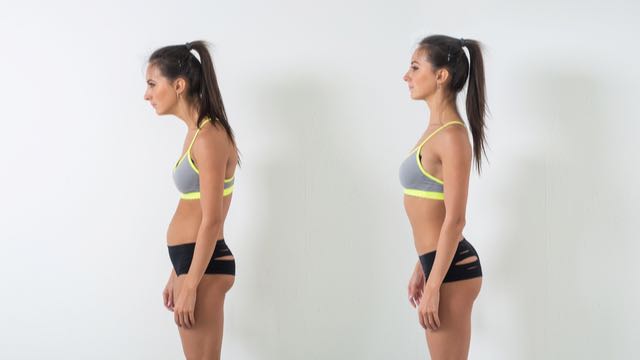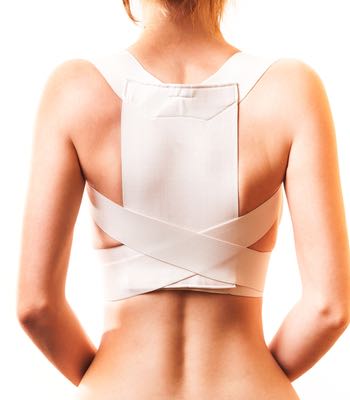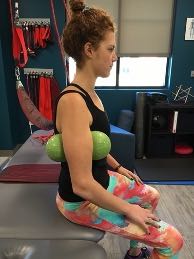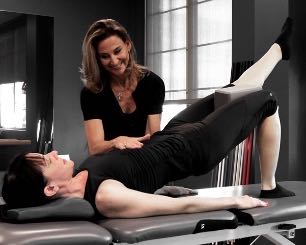Understanding Good Vs Bad Posture To Relieve Pain
How To Improve Posture?
In this article, we will gently challenge 5 myths commonly cited as solutions for fixing “bad” posture, providing you with simple truths to help increase your understanding of proper posture to sound strategies to decrease discomfort and relieve pain.
What Is Good Posture?
Many sources define proper posture as the position in which you hold your body while standing, sitting, and lying down. And further, that good posture involves training your body to maintain positions where the least strain is placed on supporting muscles and ligaments during these activities. Although I agree the goal of postural correction is one of a neutral spine, pelvis, and shoulder girdle, I am going to side with the postural great – Frederick Matthias Alexander – and affirm that proper posture is a direction, not a place, and that released neutral is a state of readiness to move not a static position in which to hold. This word choice is important because most postural strain patterns and resultant pain are due to excessive muscle tension, bracing, and gripping in the presence of instability rather than laziness or disobedience around maintaining good posture throughout the day.

Myth #1: Sit Still In The Right Place
Good posture when sitting requires you to MAINTAIN the correct position
We have all experienced episodes of back or neck tension and possibly pain after sitting for long periods of time. But what if this happens day after day, month after month, and year after year? How do we fix posture in the ‘workplace athlete’?
Musculoskeletal disorders (MSDs) are the leading cause of pain, suffering, and disability in the American workplace. OSHA has cited the direct cost associated with musculoskeletal disorders or ergonomic injuries is estimated at 15-20 billion dollars annually with indirect cost and loss 5 times that amount. Because of this, companies that assess and provide products focused on correcting bad posture by improving the ergonomics of the workplace have exploded. This is a good thing. We can all agree the desk and chair we used in middle school is not the one we will be our most productive self in as an adult.

But there is no one perfect position that can be judged as correct. Even “good” posture will become uncomfortable and a strain on your body in a short period of time if held in place. In a study out of Columbia University, the results and recommendations were clear,
“If you have a job or lifestyle where you have to sit for prolonged periods of time, we suggest taking a movement break every 30 minutes. This one behavior change could reduce your risk of death, although we don’t yet know precisely how much activity is optimal.”
Dr. Keith Diaz
There are countless studies that say the same about sitting regardless of how correct the ergonomics of the workstation, or how good your posture is maintained while seated. We have to question when the ergonomic office chair manufacturer reports, “Good ergonomic design helps the ‘workplace athlete’ stay in neutral postures longer” when the recommendation is clearly to change positions, stand up, stretch, and move at least every 30 minutes. So, with variability being key over “proper position,” the ability to effortlessly change your workstation into a standing desk, adjust your chair to a high stool, schedule infrequent walks, or create a stand and stretch routine may produce more of the results you and your employer are looking for.

Truth #1: Good Posture Requires Movement
Good posture when sitting requires you to MOVE at least every 30 minutes. Variability of position and movement is the key.
Myth #2: Sit-Up Straight
Good Posture Begins with Standing Sitting “Up Straight”
Sit up straight is a postural cue we have heard since we were children. Being the mom of three teenage boys, I have certainly found myself saying it as I pass by their slumped posture only to poke them in the side to get some sort of extensor reaction. Unfortunately, what often happens to the anatomy over time as this well-meaning suggestion to “sit up straight” goes off in our heads as the holy grail of proper posture should be discussed further.
We established in the first myth that good posture, whether sitting or standing, is not as much a static place as it is a dynamic direction. So, what is the direction we want our bodies to go in? This is a little different for everyone, but in a nutshell, we want to assume directions of length and width.
What Does This Mean?
Think about the slouched standing position in the photo to the right. It is obvious that this posture is shortening the spine forward into flexion and narrowing the front of the body by rounding the shoulders. This is certainly not optimal length or width. Yet in the next photo, where the person is straining to “stand up straight”, is not length and width either. As they pull their shoulders back and stand up or sit up straight, they are squeezing their shoulder blades together, narrowing the back of their body, extending at the rib cage, and shortening the spine back into extension. This simply exchanges one poor direction for another and creates tension that can lead to compression and pain whether we are sitting or standing.

How do we begin to find the neutral length of the spine and proper orientation of the pelvis and the shoulder girdle in width without creating excessive muscle tension? The answer lies in the rib cage and proper breathing.
Truth #2: Neutral Breathing Posture
Good Posture Begins With Proper Breathing
We breathe approximately 20,000 times a day. Breathing is by far the movement our body does the most regardless of position or activity. If there is one movement that needs to be done well, it is breathing.
Breathing and posture cannot be separated. Proper breathing occurs within a neutral orientation of the rib cage, spine, and pelvis. The Postural Restoration Institute uses the term Zone of Apposition for the proper orientation of the rib cage, spine, and thus the diaphragm – our breathing muscle. It is a complex definition, and you can read it fully here. In brief, we want the rib cage and respiratory diaphragm to sit directly above and work in coordination with our pelvis and pelvic floor diaphragm as we breathe. This is important because when they do our spine is in full length. This is the posture and direction of released neutral. Here is where we breathe most efficiently and here is where our core stabilizers are most effective in maintaining our relationship with gravity with the least amount of tension as we sit, stand, walk, and go about all our daily activities. If you want a strong core, begin with understanding this orientation of a neutral rib cage over a neutral pelvis and use this as you live, breathe, and have your being. You will be amazed at how few sit-ups are required.

Here are a few tips and simple visualizations to realize your best posture for efficient breathing.
Myth #3: Pull Your Shoulders Back
Correct your posture by pulling the shoulder blades together and down
Thus far we have established that good posture is not a place but a direction, and this direction is optimally one of length and width. We have also laid the foundation of proper breathing as the cornerstone of maintaining a dynamic released neutral direction and thus proper posture. The cue to “pull” your shoulders back, “squeeze” the shoulder blades together, and “place” them in your back pockets goes against the goals of width, length, and a released neutral upper body.
The shoulder girdle is a highly mobile and complex structure that is designed to float atop a neutral and stable rib cage. It consists of the right and left scapula or shoulder blades which literally float in a sea of muscle connecting them to the rib cage, spine, and arms via the glenohumeral joints. There are also right and left clavicles or collar bones that attach to the axial skeleton via a small ligament, and to the acromion of the scapula via another. Significant muscle balance is needed to maintain this shoulder girdle without tension occurring through the neck and mid-back.

When the rib cage, sternum, and spine are not stabilized well by the deep core muscles and breathing is not 3-dimensional and efficient, then the shoulder girdle cannot rest in released neutral. Vice versa the cue to pull your shoulders back and place your shoulder blades in your back pockets immediately pulls the rib cage into relative extension placing strain through the neck and compression through the low back.
You can feel the additional tension mount in your neck and mid-back almost immediately. You may also notice that you are breathing more into your upper chest rather than 3-dimensionally into your back and sides. This cue creates unwanted tension and places the body into an inefficient position while it attempts to move those 20,000 breaths each day.
Truth #3: Optimize Shoulder Girdle Strength
Correct your posture by balancing shoulder girdle strength.
As we illustrated above, the entire “girdle” is only attached to the rest of the core skeleton by one set of ligaments – the sternoclavicular – making the shoulder girdle an amazing collection of muscular balance and control.
Balancing the shoulder girdle requires access and coordination of the scapular stabilizer muscles without domination of anyone in particular. There are a lot of muscles that work in symphony to balance and stabilize this girdle which attaches and controls the heavy, dangling arms we use all day long. A common pattern seen and attributed to bad posture is the Upper Cross Strain Pattern. This pattern is dominated by shortened and tight pectoralis muscles in the front of the chest, the SCM muscles in the front of the neck, and sub-occipital muscles at the base of the skull, as well as lengthened and tight upper trapezius and levator scapulae in the upper back and posterior neck. The other half of the cross-pattern is inhibition and weakness of the deep neck flexors and a number of muscles in the mid-back namely the serratus anterior, rhomboids, mid and lower trapezius.

Stretches And Exercise Improves Posture
There are numerous resources that provide positioners, stretches and exercises to release the tight muscles of the upper cross strain pattern and strengthen the weak and often inhibited muscles of the deep cervical spine, mid-back, and scapula. A few are provided at the end of this article. (See references section) Regardless of the resource used, the truth around balancing the shoulder girdle and decreasing the detrimental effects of chronic Upper Cross Strain Pattern lies in the fact that both releasing what is tight and overused, AND strengthening what tends to be weak and underused is critical. This little trick we teach our patients here at the Center for Healing and Regenerative Medicine can be a game-changer in helping release the gripping patterns of the upper cross strain pattern when working at your desk. Posture correction braces are another option but beware they do not lead you into creating additional muscle tension. See the comparison below.


If we tend toward a released neutral posture free from these chronic gripping patterns, then when we set out to strengthen the shoulder girdle and mid-back, the muscles are more likely to be accessible for proper recruitment. These are sound solutions for achieving a release, balance, build approach to good posture that facilitates the direction of width across both the front and the back of the shoulder girdle. More on this concept can be found at our Physical Therapy landing page.
Myth #4: Squeeze Your Butt
Improve your posture by squeezing your butt.
Squeezing the glutes can be another frequently heard cue and a detrimental pattern of inappropriate postural stabilization to fall into. When we squeeze our gluteal muscles, this tends to tuck the pelvis into posterior tilt-up underneath the rib cage, but we are not using the correct core muscles (deep abdominals and pelvic floor) to accomplish this stabilization. If we grip with our glutes to stabilize our body within gravity, they are not readily available to do their real jobs of stabilizing the pelvis and extending the femur during standing and walking.
One can also fall into the pattern of locking out the knees into extension and hanging on ligaments at the front of the hip. This pattern in standing coupled with sitting for extended periods of time can create a cascade of muscles doing the wrong job. The hamstrings and hip flexors frequently become overworked as postural muscles rather than mover muscles resulting in tightness but also a functional weakness. Remember a tight muscle is a weak muscle because it is not readily available to do its job for the body. With inappropriate gluteal gripping we can see under or dysfunctional use of the deeper abdominal and pelvic floor muscles as well as inhibition of the deep hip rotators designed to stabilize the femur. Lower body compensatory patterns can emerge similar to the upper body ones discussed earlier.
Truth #4: Release Glutes & Strengthen Core
Improve your posture by releasing the glutes and strengthening the core.
We hear a great deal about strengthening the core. Even though there are slightly different definitions of what “core stability” really means, at the end of the day we can agree it is the coordination and neuromuscular control that allows for dynamic stabilization of the rib cage, spine, and pelvis while allowing for movement of the upper and lower extremities under variable loads and conditions.
A paraphrased Hodges and Richardson definition might read, core stabilization is the ability to maintain equilibrium and local multi-segmental control of the spine and pelvic region during extremity movement without compensatory patterns or stress beyond passive physiological limits of the ligamentous neutral zone. That is a mouthful but just remember rib cage and pelvis in orientation over and under one another is your goal.
It is also well accepted that the core stabilizers consist of four muscle groups that surround the trunk including the diaphragm from above, pelvic floor from below, the transversus abdominis from the front, and multifidus from the back. We can see how these deep local stabilizer muscles work together to stabilize what Evan Osar refers to as the thoracic-pelvic canister (TPC). When this TPC is effectively stabilized during breathing and movement, it provides proper anchoring for more global mover muscles including but not limited to the glutes, adductors, hamstrings, hip flexors, and latissimus to perform their designed roles in standing, walking, and running.

Healthy core or TPC stabilization is the cornerstone for proper neuromuscular control of the upper body via the shoulder girdle and lower body via the pelvis. It is important to train muscles at the job they were designed to perform. This can be especially challenging when muscle imbalance, weakness, and compensatory movement patterns have become habitual. If you are interested in exploring a revolutionary closed chain exercise method, Redcord Neurac, you can read more HERE.
With this therapy and exercise method one can off-load the body weight sufficiently to re-establish local core stabilization, train proper control of the shoulder and pelvic girdles, and then full kinetic chains of motion. Accessing the right muscles, at the right time, and in the right amount is key to proper posture, foundational movement, and optimal physical performance.
Myth #5: Bad Posture Leads To Pain
There are bad positions that cause your body pain
A position or posture in and of itself does not cause pain no matter how awful we consider the position to be. There is no evil place to be. There is only the static position your body is in for too long. So, if it is not the bad posture that causes pain, then what is it?
Truth #5: Tension And Compression Create Pain
It is the time spent under tension that creates compression that leads to pain.
Instead of continuing the search for the proper sitting posture that will keep you free from pain, let’s identify and change what is causing tension and compression.
Tension Is Accumulative
When we maintain a static position, tension builds, muscles grip, we overuse some muscles, underuse others, and our body becomes fatigued. Movement helps release the grip of tension and enliven the neuromuscular system once again.
Stress Is Accumulative
Stress can be mental, emotional, nutritional, or physical. As stress builds it contributes to pain. There are many ways to decrease stress, but proper breathing is at the top of the list. Getting enough sleep, eating a varied and nutritious diet, and engaging in a moderate and varied exercise program especially outdoors are all ways to decrease the accumulative stress in our lives.
Summary
Move!
Through releasing what is tight, balancing the front and back of your body, and building strength through the core, posterior shoulder girdle, and glutes.
Decrease Stress
A final thought. Instead of trying to find good posture in the proper place to hold your body, allow it to become the sum of your physical health as you eat well, sleep well, breathe well, and MOVE WELL.
References
- https://my.clevelandclinic.org/health/articles/4485-back-health-and-posture
- https://ergo-plus.com/cost-of-musculoskeletal-disorders-infographic/
- https://www.cuimc.columbia.edu/news/long-sitting-periods-may-be-just-harmful-daily-total
- https://www.goodhousekeeping.com/home-products/g33471596/best-standing-desks/
- https://www.posturalrestoration.com/
- https://drbradcole.com/wp-content/uploads/2012/02/Upper-Cross-Syndrome-Dr.-Jeff-Luebbe-2-05-12.pdf
- https://charmaustin.com/swimmers-shoulder-therapy-guide/
- https://ergonomictrends.com/best-stretches-to-improve-back-pain-at-the-desk/
- https://www.backpainseal.com/posture-corrector-for-hunched-back/
- https://www.physio-pedia.com/Core_stability
- https://iihfe.mykajabi.com/blog




